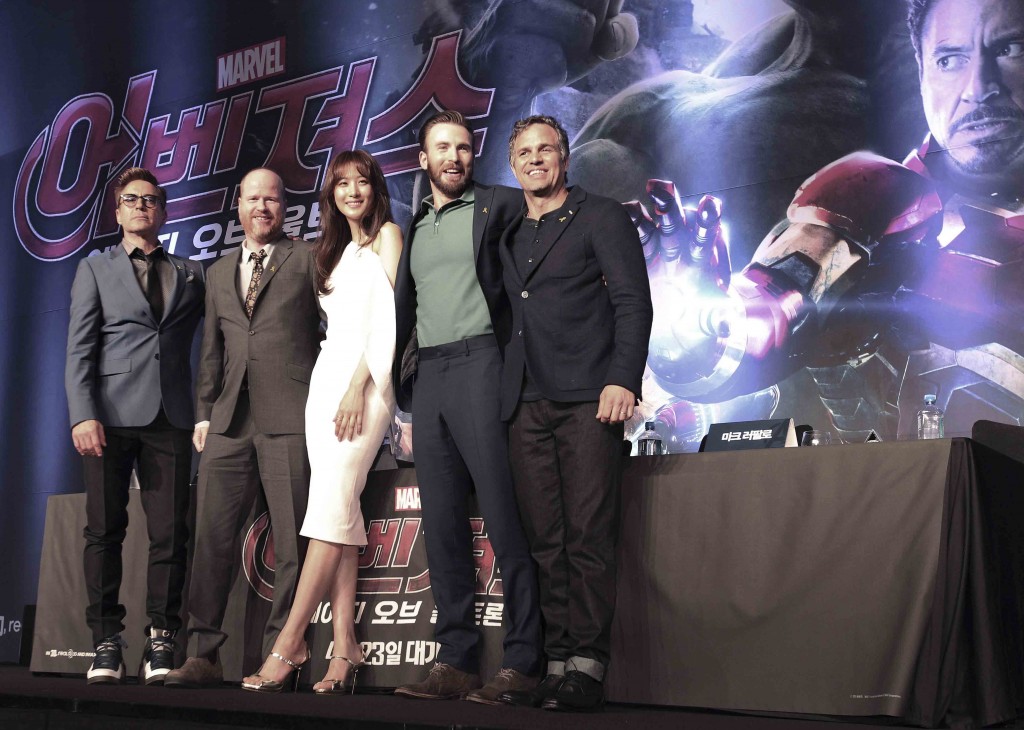- California Assembly OKs highest minimum wage in nation
- S. Korea unveils first graphic cigarette warnings
- US joins with South Korea, Japan in bid to deter North Korea
- LPGA golfer Chun In-gee finally back in action
- S. Korea won’t be top seed in final World Cup qualification round
- US men’s soccer misses 2nd straight Olympics
- US back on track in qualifying with 4-0 win over Guatemala
- High-intensity workout injuries spawn cottage industry
- CDC expands range of Zika mosquitoes into parts of Northeast
- Who knew? ‘The Walking Dead’ is helping families connect
‘Avengers’ sequel reignites screen monopoly debate in S. Korea

From left, U.S. actor Robert Downey Jr., US director Joss Whedon, South Korean actress Claudia Kim actors, U.S. actors Chris Evans and Mark Ruffalo pose during a press conference to promote their latest film “Avengers: Age of Ultron” in Seoul, South Korea, Friday, April 17, 2015. The movie will open on April 23 in South Korea. (AP Photo/Ahn Young-joon)
SEOUL, April 30 (Yonhap) — Controversy flared again here over the screen monopoly by major film distributors with the ongoing success of Hollywood blockbuster “The Avengers: Age of Ultron.”
Moviegoers complained that they can hardly find any other films in theaters these days because conglomerate-run cinema chains such as CJ CGV, Lotte Cinema and Megabox have allocated too many screens nationwide for the box-office hit, to earn as much as they can.
According to official data from the Korean Film Council, the superhero flick has been shown on 1,623 big screens across the country as of Wednesday, which accounts for 71.2 percent of the 2,281 screens available in the country.
Released here on April 23, the movie distributed by the Walt Disney Co. Korea has topped the local box office for seven straight days backed by its monopolization of cinemas.
It has attracted more than 4 million viewers in a very short period of time. Industry watchers expect the film will surpass 10 million in attendance, the standard for huge success in the South Korean film market.
In comparison, only 292 screens, about 7.4 percent of total screens, were allocated to “Salut d’Amour” by veteran Korean director Kang Je-kyu, known for “Swiri” (1999) and “TaeGukGi: BrotherHood Of War” (2004), on the same day. The romantic comedy opened only a few weeks before the Avengers film hit local theaters.
But the problem of the American film’s monopoly becomes even more serious when taking into consideration how often “Avengers 2″ is screened a day.
The film was shown 8,133 times on Wednesday, accounting for nearly 60 percent of the total screening times. This is nearly four times higher than 15.2 percent for “Coin Locker Girl,” the Korean film that sits at No. 2 on the daily box-office chart. The rate for the superhero sequel jumped to 68.3 percent on the first Sunday after it opened.
“Avengers 2″ also takes up major showing times after 8 p.m. every night, while diverse films such as “The Finishers,” for instance, was shown only twice a day, at 8:35 a.m. and midnight, at a Seoul theater.
The issue of big-budget films’ screen monopoly is not new in the Korean film industry.
As conglomerates operate the investment, distribution and screening of large films all at the same time, those that they back take up the most screens in Korean theaters, taking away chances for smaller movies to be seen.
Domestic filmmakers and producers have long raised concerns that the monopoly would hurt the diversity of films, with some raising the need to enact laws to limit the number of screens that can be allocated to a film.
“The history of the Korean film industry has always been that of a battle against monopoly,” said Eom Yong-hoon, head of Samgeori Pictures Co., the film company that produced “How To Steal A Dog”(2014).
He said the industry fought against the market dominance of Hollywood films in the past and is now combating the screen monopoly of films backed by Korean conglomerates.
Despite favorable reviews from movie critics, Eom’s film managed to attract only 305,389 viewers nationwide. Eom attributed the failure to the screen monopoly of “Ode to My Father,” which opened in the same month.
Co-produced and distributed by CJ E&M, an affiliate of food and entertainment conglomerate CJ, “Ode to My Father” was shown on up to 960 screens its opening week. It drew more than 14 million viewers.
“We can overcome a lack of quality by exerting more effort, but cannot secure capital and screens with effort because this is a structural problem,” Eom said.
A bill was previously proposed to ban films produced and invested in by the same company from monopolizing cinemas screens run by that company’s affiliates, but it died due to opposition from conglomerate-run companies, arguing that it would hurt the market economy.
Oh Dong-jin, a movie critic, warned that the monopoly situation, if continued, would result in a lack of diversity and creativity in the Korean film industry and far less attendance in theaters.
“The industry might be destroyed in five years without measures to ensure co-existence,” he said. “We need to settle the issue by setting up a double regulation that would ban a film from taking up more than 40 percent of screens nationwide and half of the number of screens at a theater.”
Edit: An earlier version of this article contained a percentage miscalculation regarding screens the “Avengers: Age of Ultron” is being shown on in South Korea. It has since been changed to the correct figure.

















Pingback: 10 Eom Accounting | Tax Accountant In
Pingback: Bookkeeping Abbr Eom | Rates for CPA Services for SMB
Pingback: Eom Bookkeeping Abbreviation | Rates for CPA Services for SMB
Pingback: 10 Eom Accounting | Rates for CPA Services for SMB